Modeling the Effect of Climate Change on Evapotranspiration in the Thrace Region
Abstract
1. Introduction
2. Materials and Methods
2.1. Research Area
2.2. Climate of the Research Area
2.3. Soil Properties of the Research Area
2.4. Plant Data
2.5. Climate Change Data
2.6. ETo Calculator
2.7. CROPWAT Model
2.8. Methods
3. Results and Discussion
3.1. Comparison of ETo Values in 2012 and Reference Period (1970–1990) with Future Short (2016–2025), Medium (2046–2055), and Long (2076–2085) Periods
3.2. Evaluation of ETo and ET (Sunflower) Values in Terms of Sunflower Cultivation in the Reference Period (1970–1990) and Future Short (2016–2025), Medium (2046–2055), and Long (2076–2085) Periods
3.3. Evaluation of ETo and ET (Wheat) Values in Terms of Wheat Cultivation in the Reference Period (1970–1990) and Future Short (2016–2025), Medium (2046–2055), and Long (2076–2085) Periods
3.4. Evaluation of ETo Values in Case of 1, 2, 3, 4 and 5 °C Increase in Temperature during the Reference Period (1970–1990)
4. Conclusions
Author Contributions
Funding
Institutional Review Board Statement
Informed Consent Statement
Data Availability Statement
Acknowledgments
Conflicts of Interest
References
- Akkaya, C.; Efeoğlu, A.; Yeşil, N. European Union Water Framework Directive and Its Applicability in Türkiye. In Proceedings of the TMMOB Water Policy Congress, Ankara, Türkiye, 21–23 March 2006; pp. 195–204. [Google Scholar]
- Elif, B. Evapotranspiration seasonal effects of climate change in Trabzon: The Penman-Monteith Method. Kastamonu Univ. J. For. Fac. 2013, 13, 300–306. [Google Scholar]
- Azlak, M. Possible Effects of Climate Change on Evaporation. Master’s Thesis, İstanbul Technical University, İstanbul, Turkey, 2015. [Google Scholar]
- Elguindi, N.; Bi, X.; Giorgi, F.; Nagarajan, B.; Pal, J.; Solmon, F.; Rauscher, S.; Zakey, A. RegCM version 3.1 user’s guide. RegCM Version 3.1 User’s Guide; ICTP: Trieste, Italy, 2007. [Google Scholar]
- Collins, W.J.; Bellouin, N.; Doutriaux-Boucher, M.; Gedney, N.; Halloran, P.; Hinton, T.; Hughes, J.; Jones, C.D.; Joshi, M.; Liddicoat, S.; et al. Development and evaluation of an Earth-System model—HadGEM2. Geosci. Model Dev. 2011, 4, 1051–1075. [Google Scholar] [CrossRef]
- Martin, G.M.; Bellouin, N.; Collins, W.J.; Culverwell, I.D.; Halloran, P.R.; Hardiman, S.C.; Hinton, T.J.; Jones, C.D.; McDonald, R.E.; McLaren, A.J.; et al. The HadGEM2 family of Met Office Unified Model climate configurations. Geosci. Model Dev. 2011, 4, 723–757. [Google Scholar] [CrossRef]
- Giorgetta, M.A.; Jungclaus, J.; Reick, C.H.; Legutke, S.; Bader, J.; Böttinger, M.; Brovkin, V.; Crueger, T.; Esch, M.; Fieg, K.; et al. Climate and carbon cycle changes from 1850 to 2100 in MPI-ESM simulations for the Coupled Model Intercomparison Project phase 5. J. Adv. Model. Earth Syst. 2013, 5, 572–597. [Google Scholar] [CrossRef]
- Voldoire, A.; Sanchez-Gomez, E.; Salas y Mélia, D.; Decharme, B.; Cassou, C.; Sénési, S.; Valcke, S.; Beau, I.; Alias, A.; Chevallier, M.; et al. The CNRM-CM5.1 global climate model: Description and basic evaluation. Clim. Dyn. 2013, 40, 2091–2121. [Google Scholar] [CrossRef]
- Republic of Türkiye Ministry of Agriculture and Forestry General Directorate of Water Management. Climate Change and Adaptation (RTMAFGDWM). Available online: https://www.tarimorman.gov.tr/SYGM/Belgeler/iklim%20de%C4%9Fi%C5%9Fikli%C4%9Finin%20su%20kaynaklar%C4%B1na%20etkisi/iklimkitap2020.pdf (accessed on 11 November 2023).
- Hanedar, A.; Ferat, Ç.; Erdem, G.; Konukcu, F.; Altürk, B.; Albut, S. TR21 Region Climate Assessment: Current Situation and Projectionsr. In Effects of Climate Change and Adaptation Strategies in TR21 Thrace Region, 1st ed.; Konukcu, F., Albut, S., Altürk, B., Eds.; Tekirdağ Namık Kemal University: Tekirdağ, Turkey, 2019; pp. 1–22. [Google Scholar]
- Kanber, R.; Baştuğ, R.; Büyüktaş, D.; Ünlü, M.; Kapur, B. Effects of Global Climate Change on Water Resources and Agricultural Irrigation. In Proceedings of the Agricultural Engineering VII, Technical Congress, Ankara, Türkiye, 11–15 January 2010; pp. 83–118. [Google Scholar]
- Turkish State Meteorological Service (TSMS). Available online: https://www.mgm.gov.tr/tarim/referans-toplam-buharlasma.aspx?s=a#sfB (accessed on 17 October 2023).
- Süzer, S. Available online: https://arastirma.tarimorman.gov.tr/ttae/Sayfalar/Detay.aspx?SayfaId=86 (accessed on 5 September 2024).
- Hurma, H. Current Status of the Agricultural Structure of the Thrace Region. In Effects of Climate Change and Adaptation Strategies in TR21 Thrace Region, 1st ed.; Konukcu, F., Albut, S., Altürk, B., Eds.; Tekirdağ Namık Kemal University: Tekirdağ, Turkey, 2019; pp. 46–60. [Google Scholar]
- Republic of Türkiye Ministry of Agriculture and Forestry (RTMAF). Available online: https://www.tarimorman.gov.tr/BUGEM/Belgeler/B%C3%BCltenler/MAYIS%202022/Ay%C3%A7i%C3%A7e%C4%9Fi%20May%C4%B1s%20%20B%C3%BClteni.pdf (accessed on 6 September 2024).
- Chaouche, K.; Neppel, L.; Dieulin, C.; Pujol, N.; Ladouche, B.; Martin, E.; Salas, D.; Caballero, Y. Analyses of precipitation, temperature and evapotranspiration in a French Mediterranean region in the context of climate change. Comptes Rendus. Géosci. 2010, 342, 234–243. [Google Scholar] [CrossRef]
- Dinpashoh, Y.; Jahanbakhsh-Asl, S.; Rasouli, A.; Foroughi, M.; Singh, V. Impact of climate change on potential evapotranspiration (case study: West and NW of Iran). Theor. Appl. Climatol. 2019, 136, 185–201. [Google Scholar] [CrossRef]
- Fan, J.; Wu, L.; Zhang, F.; Xiang, Y.; Zheng, J. Climate change effects on reference crop evapotranspiration across different climatic zones of China during 1956–2015. J. Hydrol. 2016, 542, 923–937. [Google Scholar] [CrossRef]
- Irmak, S.; Kabenge, I.; Skaggs, K.E.; Mutiibwa, D. Trend and magnitude of changes in climate variables and reference evapotranspiration over 116-yr period in the Platte River Basin, central Nebraska—USA. J. Hydrol. 2012, 420, 228–244. [Google Scholar] [CrossRef]
- Li, Y.; Qin, Y.; Rong, P. Evolution of potential evapotranspiration and its sensitivity to climate change based on the Thornthwaite, Hargreaves, and Penman–Monteith equation in environmental sensitive areas of China. Atmos. Res. 2022, 273, 106178. [Google Scholar] [CrossRef]
- Ma, Z.; Yan, N.; Wu, B.; Stein, A.; Zhu, W.; Zeng, H. Variation in actual evapotranspiration following changes in climate and vegetation cover during an ecological restoration period (2000–2015) in the Loess Plateau, China. Sci. Total Environ. 2019, 689, 534–545. [Google Scholar] [CrossRef] [PubMed]
- Sun, J.; Wang, G.; Sun, X.; Lin, S.; Hu, Z.; Huang, K. Elevation-dependent changes in reference evapotranspiration due to climate change. Hydrol. Process. 2020, 34, 5580–5594. [Google Scholar] [CrossRef]
- Nistor, M.M.; Cheval, S.; Gualtieri, A.F.; Dumitrescu, A.; Boţan, V.E.; Berni, A.; Hognogi, G.; Irimuş, I.A.; Porumb-Ghiurco, C.G. Crop evapotranspiration assessment under climate change in the Pannonian basin during 1991–2050. Meteorol. Appl. 2017, 24, 84–91. [Google Scholar] [CrossRef]
- Azlak, M.; Şaylan, L. Estimating the climate change impact on reference evapotranspiration in the Thrace Region of Turkey. Soil Water J. 2019, 8, 77–85. [Google Scholar] [CrossRef]
- Selçuk, E.B. Evaluation of the Impact of Global Warming and Climate Change on Temperature and Reference Evapotranspiration: The Case of Malatya Province. Master’s Thesis, İnönü University, Battalgazi, Türkiye, 2021. [Google Scholar]
- Arabi, C.; Candoğan, B.N. Spatial and temporal change of reference crop evapotranspiration in Marmara Region. Int. J. Agric. Wildl. Sci. 2022, 8, 268–281. [Google Scholar] [CrossRef]
- Bircan, N.; Kızıl, Ü. Development of an android-based application to be used in the calculation of reference evapotranspiration. COMU J. Agric. Fac. 2021, 9, 247–257. [Google Scholar] [CrossRef]
- Yıldırım, E.A.; Erdem, T. Investigation of the effect of climate change on reference evapotranspiration in Tekirdağ, Türkiye. Rev. Climatol. 2023, 23, 35–45. [Google Scholar] [CrossRef]
- Şen, B. Determining the changing irrigation demands of maize production in the cukurova plain under climate change scenarios with the CROPWAT model. Water 2023, 15, 4215. [Google Scholar] [CrossRef]
- Yetik, A.K.; Şen, B. Evaluation of the impacts of climate change on irrigation requirements of maize by CROPWAT Model. Gesunde Pflanz. 2023, 75, 1297–1305. [Google Scholar] [CrossRef]
- Yıldırım, Y.E.; İsmail, T.; Özaydın, K.A. Determination of spatial variation of reference evapotranspiration case study of Gediz Basin. Soil Water J. 2019, 8, 153–161. [Google Scholar] [CrossRef][Green Version]
- Deveci, H.; Konukcu, F. Prediction of climate change and its impact on water resources and crop yileds in Ergene River Basin. In Integrated Land-Use Management Modelling of Black Sea Estuaries (ILMM-BSE) Project: Ergene River Basin, 1st ed.; Konukcu, F., Ed.; Soil Offset: Tekirdağ, Turkey, 2016; pp. 269–290. [Google Scholar]
- Coşkun, A.; Deveci, H.; Konukcu, F. Prediction of the effect of climate change on wheat yield in Thrace region. Turk. J. Agric. Food Sci. Technol. 2023, 11, 933–945. [Google Scholar] [CrossRef]
- Deveci, H. Estimation of Wheat Yield under Combinations of Different Climate Parameters with the LINTUL Model in the Thrace Region. In Proceedings of the 8th International Black Sea Coastline Countries Scientific Research Conference, Sofia, Bulgaria, 29–30 August 2022. [Google Scholar]
- Konukcu, F.; Deveci, H.; Altürk, B. Modelling of the effect of climate change on wheat yield in Thrace region with AquaCrop and WOFOST models. J. Tekirdag Agric. Fac. 2020, 17, 77–96. [Google Scholar] [CrossRef]
- Altürk, B.; Bakanoğulları, F.; Konukcu, F.; Albut, S. Modeling the impact of climate change on sunflower and wheat yield in the TR21 Thrace Region. In Effects of Climate Change and Adaptation Strategies in TR21 Thrace Region, 1st ed.; Konukcu, F., Albut, S., Altürk, A., Eds.; Namık Kemal University Publications: Tekirdağ, Türkiye, 2019; pp. 104–117. [Google Scholar]
- Deveci, H.; Konukcu, F. Modeling the Effect of Climate Change on Soil Moisture in the Thrace Region. In Current Research and Assesments for Agricultural Sciences, 1st ed.; Kunter, B., Keskin, N., Eds.; Ivpe: Cetinje, Montenegro, 2019; pp. 221–235. [Google Scholar]
- Deveci, H.; Konukcu, F.; Altürk, B. Effect of climate change on wheat grown soil moisture profile in Thrace District. J. Tekirdag Agric. Fac. 2019, 16, 202–218. [Google Scholar] [CrossRef]
- Deveci, H.; Konukcu, F. Determination of Some Watershed Characteristics and Soil Properties of the Çorlu Pınarbaşı Sub-Basin with the Assistance of Geographical Information System (GIS). In Proceedings of the HASAT International Agriculture and Forest Congress, Ankara, Türkiye, 21–23 June 2019; pp. 1099–1117. [Google Scholar]
- Turkish State Meteorological Service (TSMS). Available online: https://www.mgm.gov.tr/veridegerlendirme/il-ve-ilceler-istatistik.aspx?m=TEKIRDAG (accessed on 9 September 2021).
- Republic of Türkiye Ministry of Agriculture and Forestry General Directorate of Agricultural Research and Policies (RTMAFGDARP). Available online: https://www.tarimorman.gov.tr/TAGEM/Belgeler/yayin/Tu%CC%88rkiyede%20Sulanan%20Bitkilerin%20Bitki%20Su%20Tu%CC%88ketimleri.pdf (accessed on 22 December 2023).
- Dalfes, N.; Karaca, M.; Şen, Ö.L.; Kindap, T.; Önol, B.; Turunçoğlu, U.; Bozkurt, D.; Fer, I.; Akın, H.S.; Çankur, R.; et al. Climate Scenarios for Türkiye; Proje No:105G015; TÜBİTAK: Ankara, Türkiye, 2008. [Google Scholar]
- Roeckner, E.; Bäuml, G.; Bonaventura, L.; Brokopf, R.; Esch, M.; Giorgetta, M.; Hagemann, S.; Kirchner, I.; Kornblueh, L.; Manzini, E. The Atmospheric General Circulation Model ECHAM 5. PART I: Model Description. 2003. Available online: https://pure.mpg.de/rest/items/item_995269_2/component/file_995268/content (accessed on 15 September 2024).
- Food and Agriculture Organization of the United Nations (FAO). Available online: https://www.fao.org/land-water/databases-and-software/eto-calculator/en/ (accessed on 2 August 2024).
- Allen, R.G.; Pereira, L.S.; Raes, D.; Smith, M. Crop Evapotranspiration—Guidelines for Computing Crop Water Requirements; FAO Irrigation and drainage paper 56; FAO: Rome, Italy, 1998; Volume 300, p. D05109. [Google Scholar]
- Raes, D.; Munoz, G. The ETo Calculator. In Reference Manual Version; FAO: Roma, Italy, 2009; Volume 3, p. 4. [Google Scholar]
- Food and Agriculture Organization of the United Nations (FAO). Available online: https://www.fao.org/land-water/databases-and-software/cropwat/en/ (accessed on 9 November 2023).
- Smith, M. CROPWAT, a Computer Program for Irrigation Planning and Management; FAO Irrigation and Drainage Paper No. 46; FAO: Rome, Italy, 1992. [Google Scholar]
- Kartal, S.; Çolak, Y.B.; Gönen, E.; Özfidaner, M. Using CROPWAT Program for irrigation scheduling of eggplant in Tarsus Region. Turk. J. Agric. Nat. Sci. 2019, 6, 332–342. [Google Scholar] [CrossRef]
- Clarke, D.; Smith, M.; El-Askari, K. CropWat for Windows: User guide; IHE: Oak Brook, IL, USA, 2001. [Google Scholar]
- The Irish Meteorological Service (IMS). 30 Year Averages. Available online: https://www.met.ie/climate/30-year-averages#:~:text=The%20World%20Meteorological%20Organization%20(WMO,used%20for%20two%20principal%20purposes (accessed on 14 September 2024).
- JMP. JMP Statistical Software. JMP Pro 17.0. Available online: https://www.jmp.com/en_us/home.html (accessed on 13 September 2024).
- Özkul, S.; Fıstıkoğlu, O.; Harmancıoğlu, N. Assessment of the Impact of Climate Change on Water Resources on the Büyük Menderes and Gediz Basins. In Proceedings of the TMMOB 2nd Water Policy Congress, Ankara, Türkiye, 20–22 March 2008; pp. 309–322. [Google Scholar]
- Şen, B.; Topcu, S.; Giorgi, F.; Xunqiang, B.; Kanıt, E.; Dalkılıç, T. Climate Change and Agricultural Water in Seyhan Basin Effects on Use. In Proceedings of the TMMOB 2nd Water Policy Congress, Ankara, Türkiye, 20–22 March 2008; pp. 71–82. [Google Scholar]
- Adopted, I. Climate Change 2014 Synthesis Report; IPCC: Geneva, Switzerland, 2014; pp. 1059–1072. [Google Scholar]
- Giménez, C.; Gallardo, M.; Thompson, R. Reference Module in Earth Systems and Environmental Sciences. In Plant–Water Relations; Elsevier: Amsterdam, The Netherlands, 2013. [Google Scholar] [CrossRef]
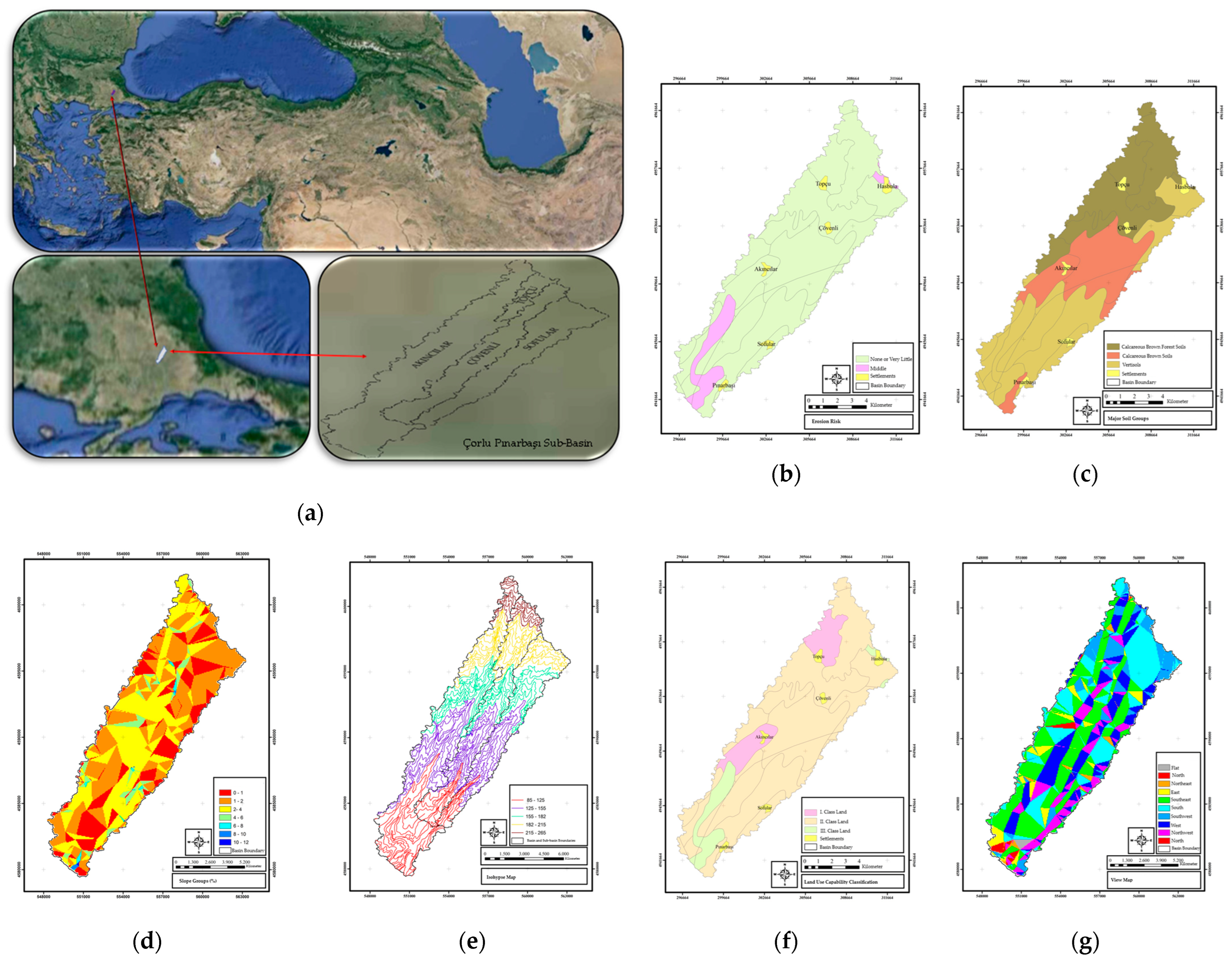
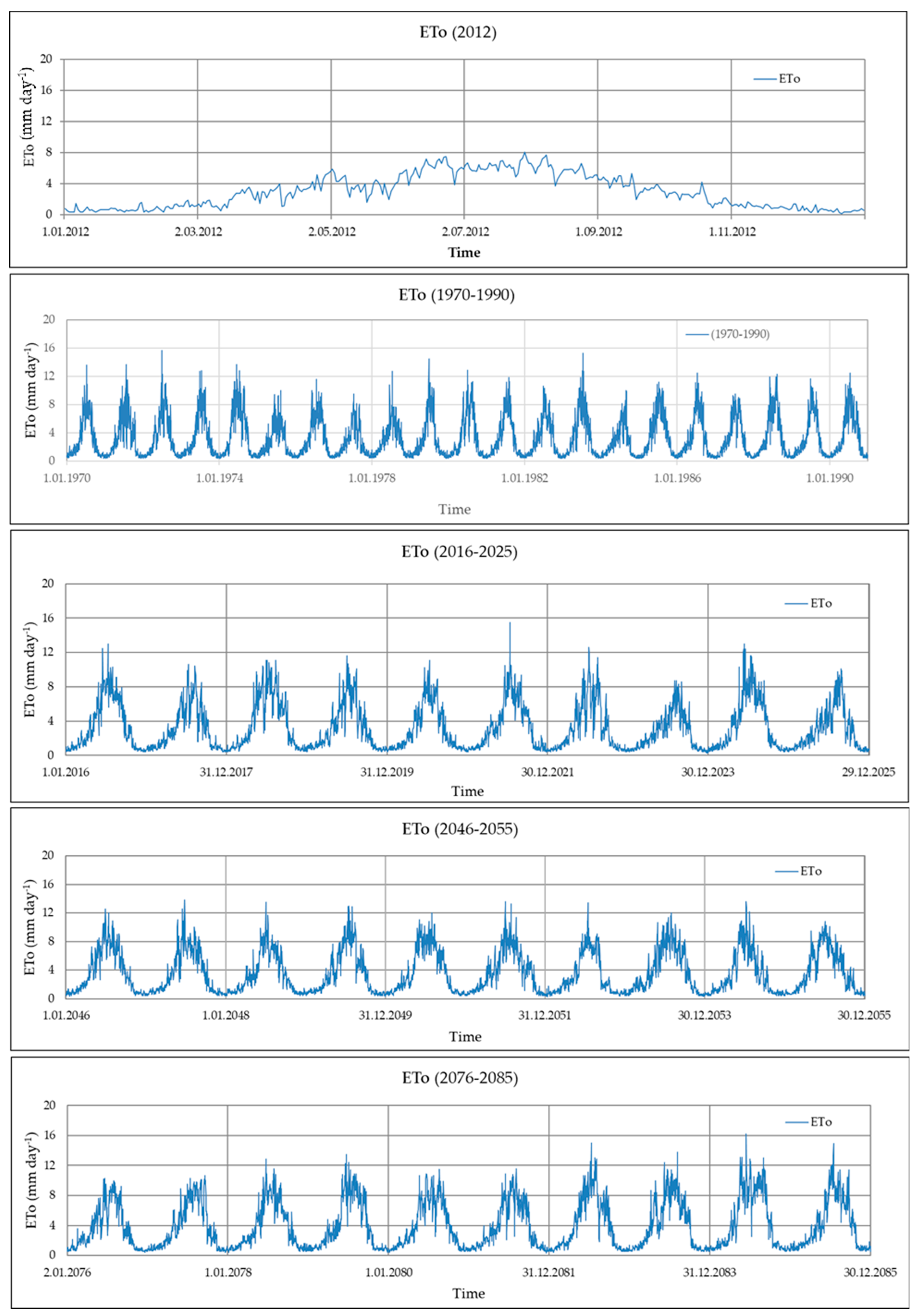

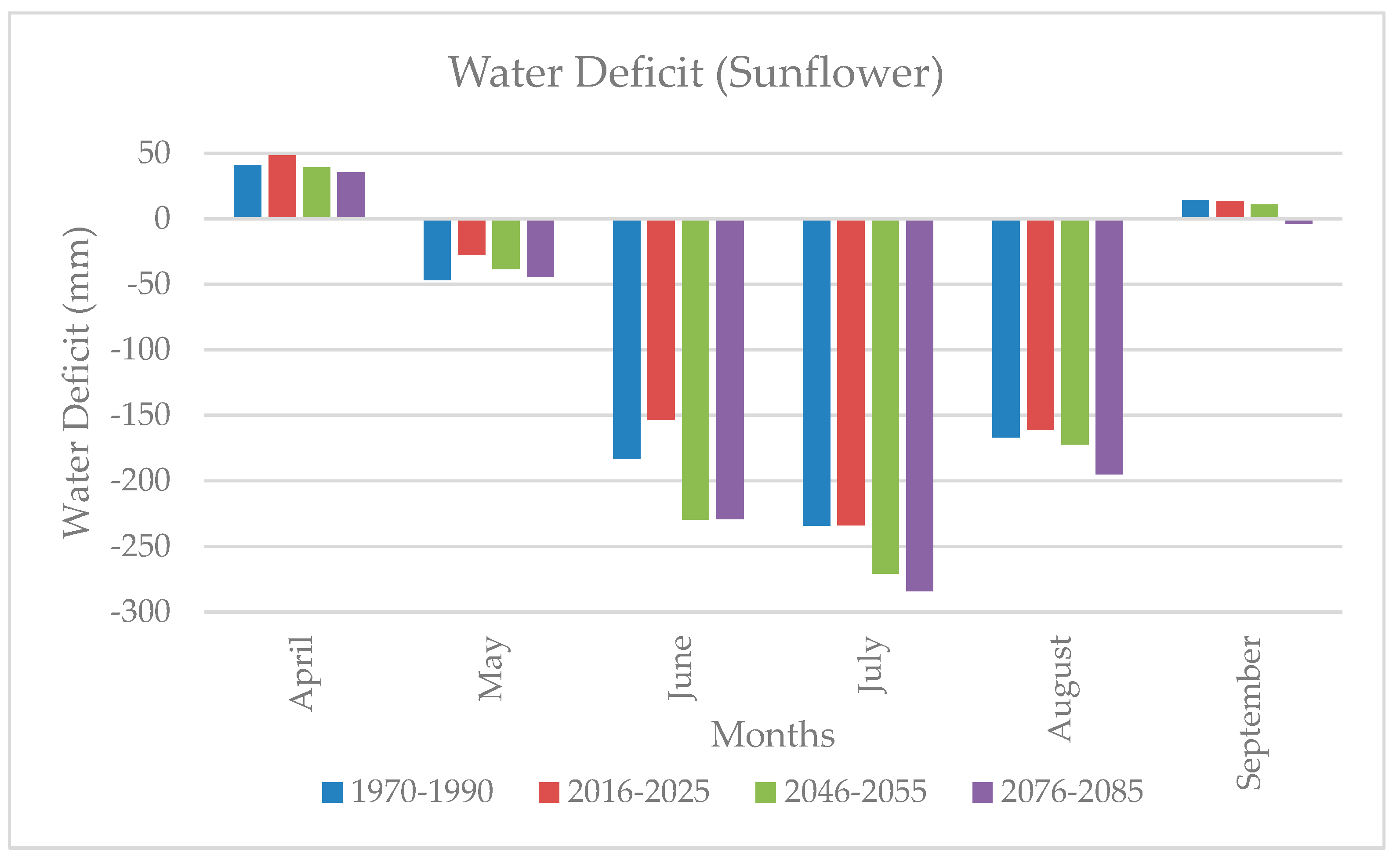
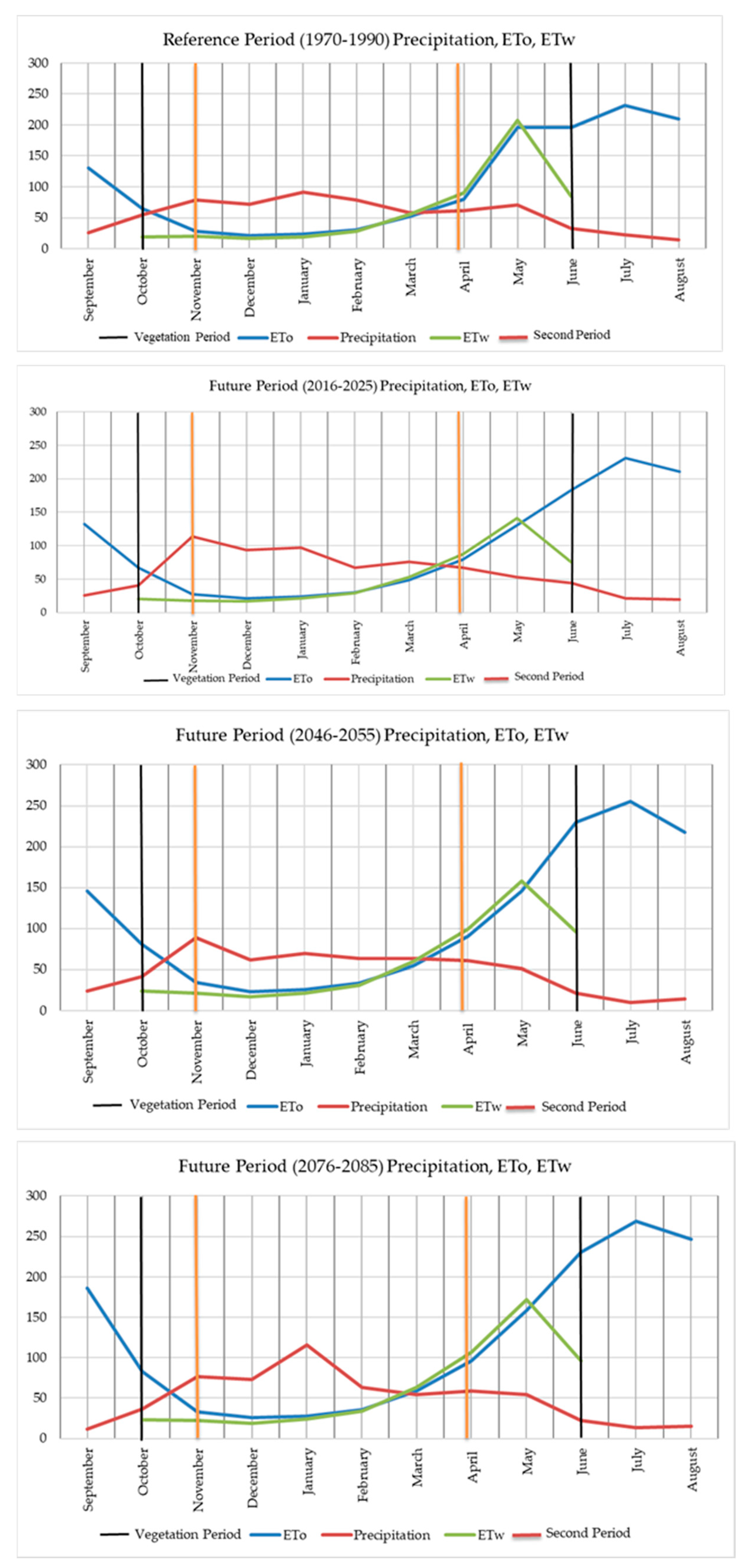

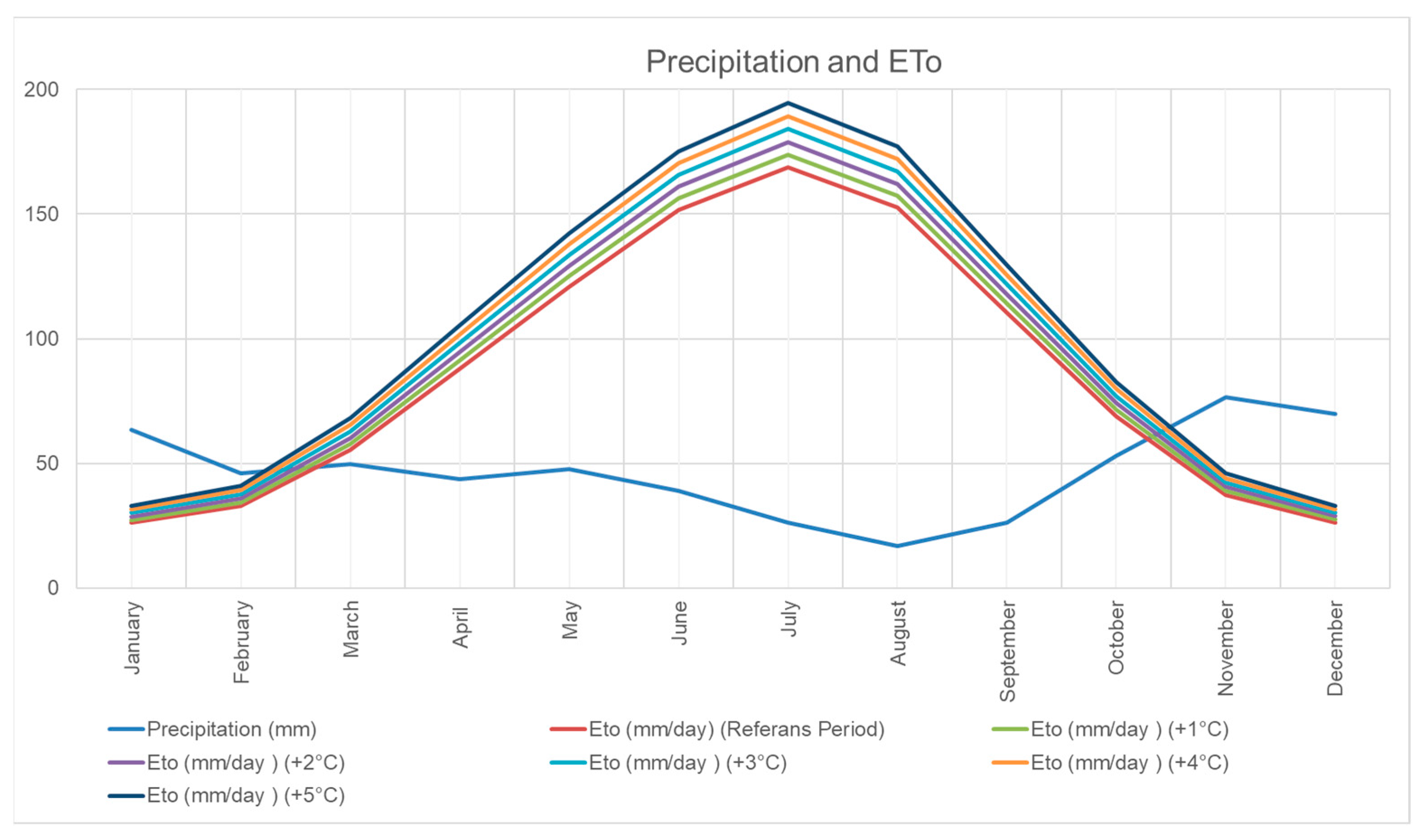
| Months | Average Temperature (°C) | Average Highest Temperature (°C) | Average Lowest Temperature (°C) | Average Radiation Time (Hour) | Average Rainy Days Number | Average Monthly Total Rainfall Amount (mm) |
|---|---|---|---|---|---|---|
| January | 4.9 | 8.1 | 2.0 | 2.8 | 12.30 | 68.0 |
| February | 5.5 | 9.0 | 2.5 | 3.4 | 10.51 | 54.5 |
| March | 7.3 | 11.0 | 4.1 | 4.2 | 10.71 | 53.4 |
| April | 11.7 | 15.7 | 8.1 | 6.0 | 9.50 | 42.1 |
| May | 16.7 | 20.6 | 12.7 | 7.4 | 8.29 | 37.2 |
| June | 21.1 | 25.3 | 16.7 | 8.5 | 7.31 | 38.3 |
| July | 23.7 | 28.1 | 19.1 | 9.4 | 3.56 | 23.8 |
| August | 23.9 | 28.3 | 19.4 | 8.4 | 2.44 | 15.5 |
| September | 20.3 | 24.5 | 16.2 | 6.8 | 4.56 | 32.7 |
| October | 15.7 | 19.5 | 12.1 | 4.9 | 7.49 | 60.2 |
| November | 11.3 | 14.8 | 8.2 | 3.2 | 9.46 | 74.3 |
| December | 7.3 | 10.5 | 4.4 | 2.5 | 11.99 | 80.0 |
| Annual/Total | 14.1 | 18.0 | 10.5 | 5.6 | 98.10 | 580.0 |
| Location of Sample | Depth (cm) | Texture | Texture Class | Bulk Density (g cm−3) | ||
|---|---|---|---|---|---|---|
| Clay (%) | Silt (%) | Sand (%) | ||||
| Akıncılar | 0–30 | 27.08 | 16.67 | 56.25 | Sandy Clay Loam | 1.57 |
| 30–60 | 29.17 | 10.42 | 60.42 | Sandy Clay Loam | 1.72 | |
| 60–90 | 29.17 | 10.42 | 60.42 | Sandy Clay Loam | 1.71 | |
| Sofular | 0–30 | 33.33 | 12.50 | 54.17 | Sandy Clay Loam | 1.53 |
| 30–60 | 29.17 | 14.58 | 56.25 | Sandy Clay Loam | 1.53 | |
| 60–90 | 37.50 | 12.50 | 50.00 | Sandy Clay | 1.46 | |
| Çövenli | 0–30 | 25.00 | 20.83 | 54.17 | Sandy Clay Loam | 1.35 |
| 30–60 | 41.67 | 14.58 | 43.75 | Clay | 1.38 | |
| 60–90 | 39.58 | 14.58 | 45.89 | Sandy Clay Loam | 1.37 | |
| Crop Parameters | Sunflower | Wheat | |
|---|---|---|---|
| Crop Development Period (days) | Initial | 25 | 30 |
| Developement | 30 | 146 | |
| Mid-Season | 60 | 47 | |
| Late-Season | 30 | 30 | |
| Crop Cofficient (Kc) | Initial | 0.40 | 0.62 |
| Mid-Season | 1.11 | 1.09 | |
| Late-Season | 1.31 | 0.20 | |
| Vegetation Duration (days) | 145 | 252 | |
| Period | ETo Values (mm Day−1) | ||
|---|---|---|---|
| Minimum | Maximum | Average | |
| 2012 | 0.2 | 8.1 | 3.0 |
| 1970–1990 | 0.3 | 15.7 | 3.3 |
| 2016–2024 | 0.3 | 9.3 | 3.3 |
| 2016–2025 | 0.3 | 15.5 | 3.2 |
| 2046–2055 | 0.3 | 13.8 | 3.6 |
| 2076–2085 | 0.3 | 16.2 | 4.0 |
Disclaimer/Publisher’s Note: The statements, opinions and data contained in all publications are solely those of the individual author(s) and contributor(s) and not of MDPI and/or the editor(s). MDPI and/or the editor(s) disclaim responsibility for any injury to people or property resulting from any ideas, methods, instructions or products referred to in the content. |
© 2024 by the authors. Licensee MDPI, Basel, Switzerland. This article is an open access article distributed under the terms and conditions of the Creative Commons Attribution (CC BY) license (https://creativecommons.org/licenses/by/4.0/).
Share and Cite
Deveci, H.; Konukcu, F. Modeling the Effect of Climate Change on Evapotranspiration in the Thrace Region. Atmosphere 2024, 15, 1188. https://doi.org/10.3390/atmos15101188
Deveci H, Konukcu F. Modeling the Effect of Climate Change on Evapotranspiration in the Thrace Region. Atmosphere. 2024; 15(10):1188. https://doi.org/10.3390/atmos15101188
Chicago/Turabian StyleDeveci, Huzur, and Fatih Konukcu. 2024. "Modeling the Effect of Climate Change on Evapotranspiration in the Thrace Region" Atmosphere 15, no. 10: 1188. https://doi.org/10.3390/atmos15101188
APA StyleDeveci, H., & Konukcu, F. (2024). Modeling the Effect of Climate Change on Evapotranspiration in the Thrace Region. Atmosphere, 15(10), 1188. https://doi.org/10.3390/atmos15101188








